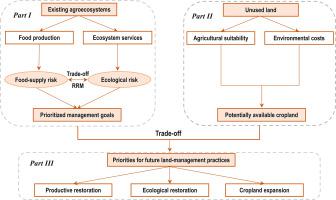Agricultural Systems ( IF 6.6 ) Pub Date : 2021-12-06 , DOI: 10.1016/j.agsy.2021.103342 Dawei Hou 1 , Fanhao Meng 2 , Chao Ji 1 , Li Xie 1 , Wenjuan Zhu 1 , Shizhong Wang 3 , Hua Sun 1

|
CONTEXT
Sustainable land-use systems require clear decision-making protocols across institutions and departments. However, food production and ecological conservation are often regarded as separate or even incompatible policy goals, resulting in sustainability challenges and unclear land-management practices. More recently, with the introduction of Sustainable Development Goals (SDGs), there has been growing interests in minimizing the possible trade-offs between the two policy goals through appropriate governance.
OBJECTIVE
The objective of this study was to develop a systematic framework for assessing current land-management practices and specifying future priorities.
METHODS
The systematic framework included three modules and considered agroecosystems covering each administrative unit as the research objects. In the risk assessment module, we modified traditional relative risk model (RRM) to assess the risk that current management practices may affect food production and non-provisioning ecosystem services in existing agroecosystems, respectively. The framework also included a module to identify potentially available cropland (PAC) based on a combination of agricultural suitability and environmental costs for future reclamation. Finally, priorities for future land-management practices were specified based on the trade-offs between cropland expansion, ecological restoration and productive restoration. Jiangsu Province in eastern China was taken as a case study to verify the applicability of our framework.
RESULTS AND CONCLUSIONS
Using Jiangsu Province as a case study, we have verified the applicability of our framework in prioritizing future land-management practices at a county level. The framework can offer a prioritization mechanism for formulating targeted strategies under alternative scenarios to correspond with varying management goals. The RRM can separate adverse effects from multiple stressors on food production and environmental outcomes rather than confounding the two interactive functions, while the risk scores and ranks generated for each sub-region, stressor and endpoint can pave the way for detailed and targeted governances. In addition, the identification of PAC can highlight areas for future cropland expansion.
SIGNIFICANCE
The proposed framework can provide important insights and tools for avoiding institutional conflicts regarding land-management governance. Due to the simplicity and comparability, it can not only be applicable to our particular site, but also be used for different locations or downscaled to a landscape level.



























 京公网安备 11010802027423号
京公网安备 11010802027423号